News
News
Betty Campbell Commission
It’s all been very top secret over the last 2 years, but I can now tell you about the project that I’ve been working on!
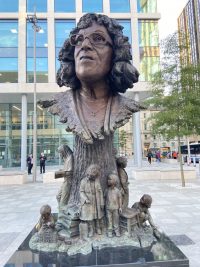
In May 2019 I won a commission to sculpt Betty Campbell, she was amongst many other things, Wales’s first black headteacher. The piece is for Cardiff City Centre, unfortunately I can’t tell you much about the design until the unveiling, but it has been described as iconic, powerful, originally unique, imaginative and inspirational. Let’s hope that piece lives up to its reputation so far. All I can tell you is that it was a mighty ambitious piece even for me and a very brave and prophetic choice from the commissioners “The Monumental Welsh Women”.
The unveiling for Betty is on the 29th of September!!!
It’s a very exciting time!
For me its exciting not only to remember Betty’s important legacy, but also for the long-overdue giving of a voice to the voiceless. In other words, to attempt to add a little weight to the hovering and unconsidered end of the UKs, and the worlds, equality scales when it comes to the portrayal of women and non-white people within public sculpture.
At the start of this project the statue of Edward Colston was still looming above the public on his plinth for another 12 months and George Floyd was still alive. Thank goodness that the tide is now turning within our society, and I believe Betty’s monument is a testament to this.
I have had the total privilege and honour to create a monument which is a celebration of diversity. I hope this sculpture is a fitting tribute to Cardiff and Tiger Bay, the richly diverse community in which Betty grew up in and loved. I aimed to continue through this monument, the education in which Betty felt so passionately about, especially black education.
And finally, I hoped to pay homage to Betty, this precious and formidable woman, to allow her legacy and memory to live on.
You will find once the piece is unveiled that Betty’s monument is ladened with lots of hidden stories, I’m always interested to hear your thoughts and findings within the pieces I create and Betty’s monument is no exception, please do get in touch.
For further reading here are some links.
https://monumentalwelshwomen.com/the-statues
https://www.bbc.co.uk/news/uk-wales-48610689
https://cardiffjournalism.co.uk/thecardiffian/2021/06/15/this-is-when-betty-campbells-statue-will-
https://cardiffstudentmedia.co.uk/gairrhydd/feature-betty-campbell/
https://www.invisiblewomen.org.uk/gettingattention?page=4
PLEASE TAKE A MINUTE TO VIEW MY YOUTUBE VIDEO ON MY EMILY WILLIAMSON PIECE
In February 2021 I wrote this. See below for the update!
EMILY WILLIAMSON – Eve Shepherd longlisted for RSPB sculpture
“I have been long listed for a competition to create a bronze sculpture of Emily Williamson the co-founder of the RSPB. The sculpture will be located in the garden of Fletcher Moss Park Emily’s home in Didsbury near Manchester.
I need your vote, so if you have a mo, could you please follow the link below and place your vote!
https://www.emilywilliamsonstatue.com/sculptorslonglist
Many thanks”
I would like to create a piece of work that not only depicts the great woman Emily Williamson, but also depicts what she did within her life and the fantastic legacy she left us with.
Please see images below supplied for the initial response to the statue.
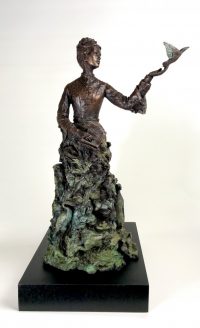
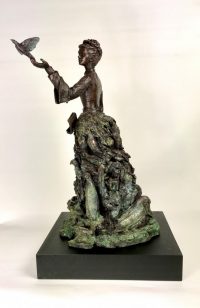
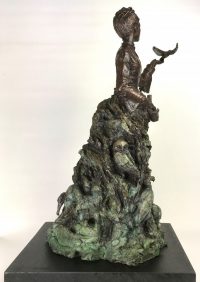
As the viewers eye travels down the figure the lower section of the piece, (just below her waist and where her skirt begins), I would like to acknowledge the environmental and social aspects of Emily’s work. From a distance her skirt will look like an ordinary crinoline dress with a bustle, however once the viewer is drawn closer to the piece one will notice that Emily’s dress is really a an organic cliff face, treetop nesting ground complete with sculpted depictions of the birds she worked so hard to save. These birds will be lifelike and miniature, nesting within the folds of Emily’s dress, indeed her garment is to be made to look like the natural often protected environments that the birds would live.My suggestion would be that I create a lifelike standing bronze portrait of Emily Williamson possibly holding and freeing a bird from her hand. Her stance is strong yet gentle, her expression and the tilt of her head show kindness yet stoic qualities.
Also hidden within her dress/landscape would be small scenes/dioramas depicting the women and girls that she helped to retrain out of the gruelling feather trade as well as a couple of hidden cameo portraits of other relevant great women mentioned in Tessa Boase’s brilliant book ‘The Purple Feather’, for example Eliza Philips, Etta Lemon and the Duchess of Portland.
From a distance the statue will be striking showing Emily lifting a bird and releasing it to freedom , this is not only an acknowledgment of Emily’s achievements in protecting the birds, but is also a reflection on how she helped free the women and girls out of the inhuman and gruelling life of the feather trade.
As the viewer moves closer to the statue the hidden detail is designed not only to draw the audience closer to investigate the sculpture further, but it also encourages the viewers to ask questions and to keep coming back to see the statue as each visit reveals something new.
Stood in the beautiful surroundings of the garden, on a low plinth, Emily’s statue is designed ‘belong’ to her setting. The organic nature and texture of the bronze with verdigris and antique bronze patination will help the piece to blend in and almost merge with it’s surroundings.
I believe this piece will be a unique, powerful and sensitive portrayal of an important woman, as she stands within the beloved natural surroundings of her garden, she’s shown holding, housing and protecting the people and the wildlife she cared so much about. I hope the statue will shed light upon the precious legacy of Emily and her peers passionate yet strategic fight with cruelty and injustice.
Emily Williamson was a forward thinking, kindly and truly inspirational woman – but I see this statue as also celebrating woman-kind and animal-kind as a whole. I’m known for taking on challenging projects and giving a voice to those people and causes that often lie hidden or have been silenced throughout history.
Here, Emily Williamson is freeing a bird from her hand. Her stance is strong yet gentle, her expression and the tilt of her head show kindness yet stoic qualities. As the viewer’s eye travels down the figure, the lower section of the piece acknowledges the environmental and social aspects of Emily’s work.
From a distance her skirt will look like an ordinary crinoline dress with a bustle, but close up it’s an organic cliff face; a nesting ground depiction of the birds she worked so hard to save from the plumage trade. These birds will be lifelike and miniature, nesting within the folds of the dress as if in their natural environments. Can you spot, for example, an owl, kingfisher, snowy egret, penguin and a fledgling?
Also hidden within her dress/landscape are small scenes/dioramas depicting other women relevant to her story – for example Eliza Philips, Etta Lemon and the Duchess of Portland, who, together with Emily Williamson, built the early RSPB.
Here is a link to the long list: www.emilywilliamsonstatue.com
The more people who vote for this piece, the more chance I have of producing it.
Please visit the website and vote.
EMILY WILLIAMSON – Longlisted for RSPB sculpture
Emily Williamson was a forward thinking, kindly and truly inspirational woman – but I see this statue as also celebrating woman-kind and animal-kind as a whole. I’m known for taking on challenging projects and giving a voice to those people and causes that often lie hidden or have been silenced throughout history.
Here, Emily Williamson is freeing a bird from her hand. Her stance is strong yet gentle, her expression and the tilt of her head show kindness yet stoic qualities. As the viewer’s eye travels down the figure, the lower section of the piece acknowledges the environmental and social aspects of Emily’s work.
From a distance her skirt will look like an ordinary crinoline dress with a bustle, but close up it’s an organic cliff face; a nesting ground depiction of the birds she worked so hard to save from the plumage trade. These birds will be lifelike and miniature, nesting within the folds of the dress as if in their natural environments. Can you spot, for example, an owl, kingfisher, snowy egret, penguin and a fledgling?
Also hidden within her dress/landscape are small scenes/dioramas depicting other women relevant to her story – for example Eliza Philips, Etta Lemon and the Duchess of Portland, who, together with Emily Williamson, built the early RSPB.
Puffin
These birds are currently on the RSPB most endangered RED list.
Snowy Egret
Hunted to the brink of extinction for its plume and saved by the RSPB
Albatross
This bird is very important in the sculpture.
- a) The Albatross is currently in the RSPB’s RED list of endangered birds. Today, the RSPB Albatross Task Force is trying to save this beautiful creature.
- b) They were also used in the millinery industry.
- c) I selected this bird as it is one of my favourites and because of the poem ‘The Rime of the Ancient Mariner’ by Samuel L Coleridge. In the poem one mariners thoughtless act of killing an albatross on board a drifting ship brought death to his crew mates. I wonder if this could be a lesson in our current climate crisis?
Avocet
The Avocet is the champion of the RSPB conservation effort and the bird now used on the RSPB’s logo. This incredible bird was once extinct in the UK, but through RSPB conservation programs have brought the bird back and is now reaching record numbers.
Tawny Owl
These birds are currently on the RSPB most Amber list.
Yellow Eyed Penguin
These birds are currently very endangered, their numbers are declining due to the (by catch) from the fishing industry.
Great-crested Grebe
This bird is one of Emily’s favourite birds and was fundamental to the formation of the RSPB, she saw how the birds were depleting rapidly in numbers. Hunted to the brink of extinction for the millinery industry they are now in the Green (safe) status within current conservation listings.
Kingfisher
Can you spot the kingfisher, its one of the hardest to spot in the sculpture! Kingfishers were a favourite in the millinery industry and today is on the RSPB’s Amber list.
Other birds to spot What other birds can you spot in the sculpture? There are more important birds which I’ve included in this sculpture, they were either used in the millinery industry or are being helped by the RSPB today.
 Bird on Emily’s Hand
Bird on Emily’s Hand
This birds ‘form’ is based on a starling, this nods a cap to Mellissa, Emily’s great, great niece who, even though she didn’t know of her Auntie Emily’s incredible achievements as founder of the RSPB, chose to study starlings for a living.
This bird is very important it shows Emily releasing the bird into the wild, as Emily in her life and her legacy protected all birds, this bird is made up of lots of birds, like a murmuration.
Diorama 1 – Nurse and child
Emily cared a lot about people as well as birds, she founded the Princess Christian Training College for Nurses. Here Emily introduced using real children in their training instead of dolls. The sculpture shows a nurse helping a small child.
Diorama 2 – Feather workers
The feather trade was known for its cruel use of female labourers, girls as young as 5 were worked for long hours often using toxic chemicals to produce the plumes for hats. Emily also founded the Gentle Women’s Employment Association.
Emily’s Locket
Too small on the sculpture to make, but Emily’s locket will show the other 2 founders of the RSPB, Etta Lemon and Eliza Philips, these are incredible women in their own right, not taking ‘no’ for an answer!
Plumage Act 1921
Emily is holding the Plumage Act in her hand.
The RSPB
Managed on the 1st July 1921 to get their Plumage Act agreed in the House of Parliament, this meant that feather and bird skins were not allowed to be imported into the UK, thereby rendering the use of feathers in fashion obsolete.
Emily’s Skirt / The birds habitats
Emily’s dress shows the various habitats which birds live in. Healthy, unpolluted environments are important for animals and birds to live happy, healthy lives. The RSPB helps to make and maintain good habitats. How many different bird habitats can you find in the sculpture?
Emily’s pose and expression
Emily has been described as quietly dignified and determined. I thought that she must also have been a very strong and caring person. These are the personality traits Emily would have needed to create such an important organisation in the ‘man’s world’ she lived in.
2019 Blood and Bone, Brighton
Eve Shepherd at the Corridor Gallery, Brighton
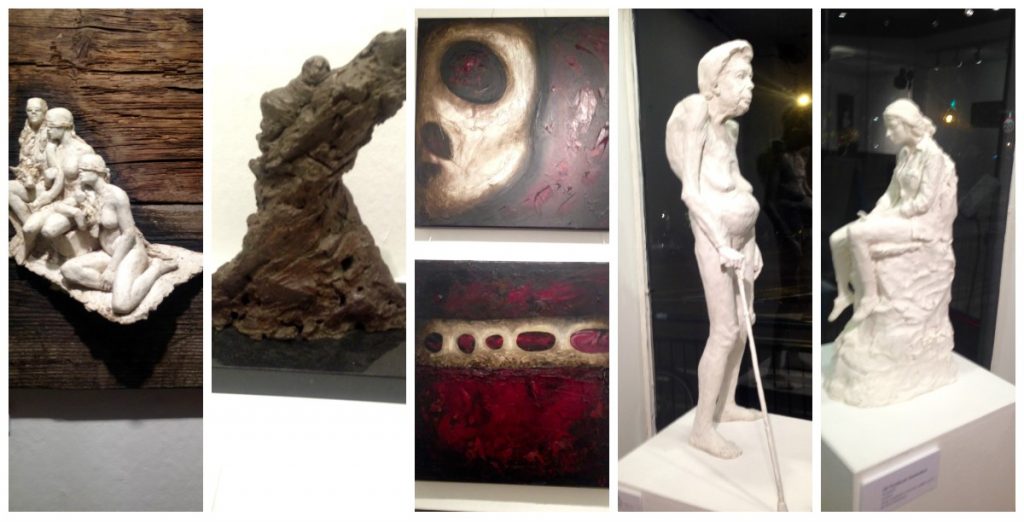 The Verse’s Melanie Valenzia shares her views on Eve Shepherd’s sculpture exhibition at Brighton’s Corridor Gallery.
The Verse’s Melanie Valenzia shares her views on Eve Shepherd’s sculpture exhibition at Brighton’s Corridor Gallery.
“Blood and Bone explores the female archetypes, touching on physicality and womanhood. Throughout this collection of work, Eve Shepherd successfully tells the story of the never-ending cycle that is ‘female ancestry’. It is evident in her work that Eve is highly skilled with her materials and techniques, showing particular knowledge of the human anatomy. Eve began her training under animal sculptor Anthony Bennett at the age of seventeen, and eventually worked her way up to the role as head of the sculpture department at Scenic Route. Throughout her career, Eve has worked at a fast and accurate pace, producing work to meet high demands, which is why she is so confident and fluid in her skills today. She notes the work of sculptors Barbara Hepworth and Branscusi, as work she admires.
The first thing that struck me about these pieces, was their fragility and haunting appearances, and there was something so delicate about the elongated and ghostly figures. The female forms were not perfected or idealised, but rather full of character that was expressed through the emotion in their faces and life-like stances. One of my favourite pieces in the exhibition was the work called Blood Line. It features three figures, an elderly woman, a mother and a young girl. The older woman towering over the young girl, who stretches her neck to look up towards them. It is an emotional piece, and becomes even more so as you begin to unravel it; all figures are joined at the base and there is a sense of nostalgia in the expressions of the older women as they look down on what physically was their past selves. On the other hand, there is a sense of curiosity and excitement, as the young girl looks up to what she has yet to experience.
Eve’s sensitivity and attention to every detail of her work, from the making to the presentation is truly amazing. The mediums she used were carefully selected to echo the subject of her work; the iron used in the firing of the pieces is left evident in most of the bases of the sculptures, alluding to the idea of blood. Her use of clay, which is a natural material, could be referring to the idea of bone. Three oil paintings were included in this exhibition, depicting blood and bone and actual bone material was used in the pigment of the paint. Although Eve says that she is still building her confidence in painting, the exhibited pieces in what could be a triptych give the exhibition a sense of diversity.
Walking through the exhibition, all the pieces worked together in harmony and the intimate gallery space was ideal for such an emotionally engaging subject. It was clear that the artist had control over how the works were to be presented, which was refreshing to see, and allowed the artist’s voice to be heard beyond the pieces themselves. For example, the works ‘Dignified’ and ‘Facebook Generation’ were two pieces that were not made together, however their shapes echo one another. Placing them side-by-side seems only natural, and that small detail really brought the artist’s thoughts.
The works included in Blood and Bone show clear craftsmanship and skill, yet like the traditional techniques used in these pieces encompass a subject that is contemporary and relatable. Eve’s work is thought-provoking and her painterly-like style is so genuine, it is invigorating to witness an artist who is so hands-on”


